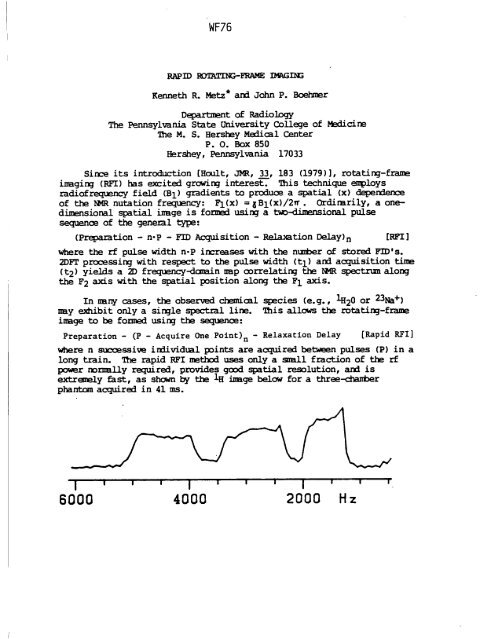th - 1987 - 51st ENC Conference
th - 1987 - 51st ENC Conference
th - 1987 - 51st ENC Conference
You also want an ePaper? Increase the reach of your titles
YUMPU automatically turns print PDFs into web optimized ePapers that Google loves.
WF76<br />
RAPID ~ F R A M E IMAGING<br />
Kenne<strong>th</strong> R. Metz* and John P. Boehmer<br />
Department of Radiology<br />
The Pennsylvania State University College of Medicine<br />
~he M. S. Hershey Medical Center<br />
P. O. Box 850<br />
Hershey, Pennsylvania 17033<br />
Since its introduction [Hcult, J~R, 33, 183 (1979)], rotating-frame<br />
imging (RFI) has excited growing interest. This technique employs<br />
radiofrequency field (B I) gradients to produce a spatial (x) dependence<br />
of <strong>th</strong>e NMR nutation frequency: Fl(x) = ~Bl(X)/2~. Ordinarily, a one-<br />
dimensional spat/al image is formed using a t%D-dimensional pulse<br />
sequence of <strong>th</strong>e genen~l type:<br />
(Preparation - n-P - FID Acquisition - Relaxation Delay) n [RFI]<br />
where <strong>th</strong>e rf pulse wid<strong>th</strong> n-P increases wi<strong>th</strong> <strong>th</strong>e number of stored FID's.<br />
2DPT processing wi<strong>th</strong> respect to <strong>th</strong>e pulse wid<strong>th</strong> (t I) and acquisition time<br />
(t 2) yields a 2D frequency-dum~in map correlating <strong>th</strong>e NMR spectrum along<br />
<strong>th</strong>e F 2 axis wi<strong>th</strong> <strong>th</strong>e spatial position along <strong>th</strong>e F 1 axis.<br />
In many cases, <strong>th</strong>e obserut~ chemical species (e.g., IH20 or 23Na+)<br />
may exhibit only a single spectral line. ~his allows <strong>th</strong>e rotating-frame<br />
imge to be formed using <strong>th</strong>e sequence:<br />
Preparation - (P - Acquire One Point) n - Relaxation Delay [Rapid RFI]<br />
where n s~ssi~ individual points are acquired between pulses (P) in a<br />
long train. The rapid RFI me<strong>th</strong>od uses only a small fraction of <strong>th</strong>e rf<br />
power normally required, provides, good spatial resolution, and is<br />
extremely fast, as shown by <strong>th</strong>e I~ image below for a <strong>th</strong>ree-c/hamber<br />
phantcm acquired in 41 ms.<br />
l ' ' ' i ' ' ' I ' '<br />
6000 4000 2000 Hz













